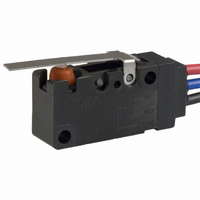D2VW-5L1-1MS Omron, D2VW-5L1-1MS Datasheet - Page 6

D2VW-5L1-1MS
Manufacturer Part Number
D2VW-5L1-1MS
Description
MICRO SWITCH, SPDT-1NO/1NC, 5A, 250V
Manufacturer
Omron
Series
D2VWr
Type
Snap Actionr
Specifications of D2VW-5L1-1MS
Microswitch Type
Miniature
Contact Voltage Ac Nom
250V
Contact Current Max
5A
Switch Terminals
Wire Leaded
Circuitry
SPDT-1NO/1NC
Leaded Process Compatible
Yes
Circuit
SPDT
Switch Function
On-Mom
Contact Rating @ Voltage
5A @ 125VAC
Actuator Type
Lever, Straight
Mounting Type
Chassis Mount
Termination Style
Wire Leads
Operating Force
120gf
Contact Form
SPDT
Contact Rating
3 Amps at 125 Volts, 250 Volts
Actuator
Lever, Hinge
Body Style
Miniature
Brand/series
D2VW Series
Current, Rating
5 A
Dielectric Strength
1500 VAC
Ip Rating
IP67
Mounting Hole Size
3.1 mm
Number Of Poles
1
Operation
Snap Action
Standards
IEC Approved
Temperature, Operating
-40 to +90 °C
Termination
Lead Wire
Voltage, Rating
250/30 VAC/VDC
Lead Free Status / RoHS Status
Lead free / RoHS Compliant
Lead Free Status / RoHS Status
Lead free / RoHS Compliant, Lead free / RoHS Compliant
Other names
D2VW5L11MS
SW436
SW436
Precautions
Be sure to read the precautions and information common to all Snap Action and Detection Switches, contained in the Technical User’s Guide,
“Snap Action Switches, Technical Information” for correct use.
■ Correct Use
Operations
Make sure that the switching object is perfectly separated from the
actuator when the switch is not operated and the actuator is pressed
appropriately by the switching object when the switch is operated.
The switch should be set so that its stroke will be within the rated OT
when the switch is operated.
With the pin plunger models, set the switch so that the plunger can
be actuated from directly above. Since the plunger is covered with a
rubber cap, applying a force from lateral directions may cause
damage to the plunger or reduction in the sealing capability.
Handling
Handle the switch carefully so as not to break the sealing rubber of
the plunger.
Using Microloads
Using a model for ordinary loads to switch microloads may result in
faulty operation. Instead, use the models that are designed for
microloads and that operate in the following range;
However, even when using microload models within the operating
range shown above, if inrush current or inductive voltage spikes
occur when the contact is opened or closed, then contact wear may
increase and so decrease the service life. Therefore, insert a contact
protection circuit where necessary.
212
30
24
12
5
0
Sealed Snap Action Switch
0.16mA
Inoperable
range
Incorrect
1mA
1
Correct
Operating range
for micro load
models D2VW-01
Incorrect
10
26mA
100mA 160mA
100mA
Current (mA)
100
Operating
range for
general-load
models
D2VW-05
D2VW
1,000
■ Cautions
Degree of Protection
The D2VW was tested under water and passed the following water-
tightness test, which however, does not mean that the D2VW can be
used in the water.
JIS C0929 (rules for testing the watertightness of electrical devices
and materials), class 7 (watertightness test). Refer to the following
illustration for the test method at OMRON.
Note: The object to be tested is left in the water for 30 minutes on con-
Protection Against Chemicals
Prevent the switch from coming into contact with oil and chemicals.
Otherwise, damage to or deterioration of the switch materials may
occur.
dition that the distance between the surface of the water and
the top of the object be 15 cm minimum and the distance be-
tween the surface of the water and the bottom of the object be
1 m minimum.















